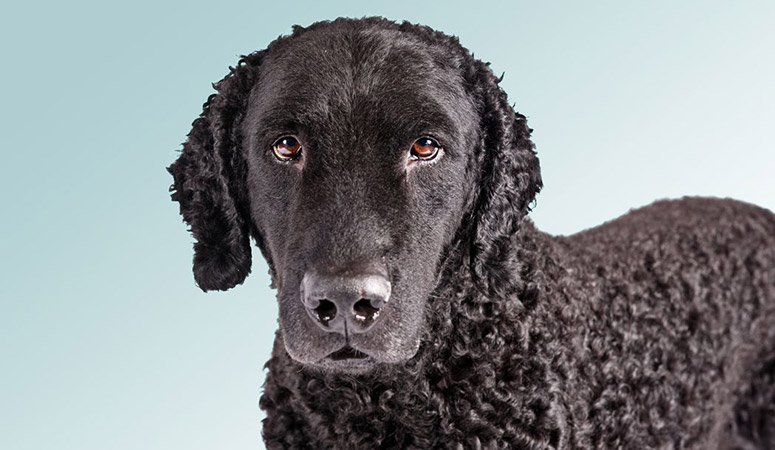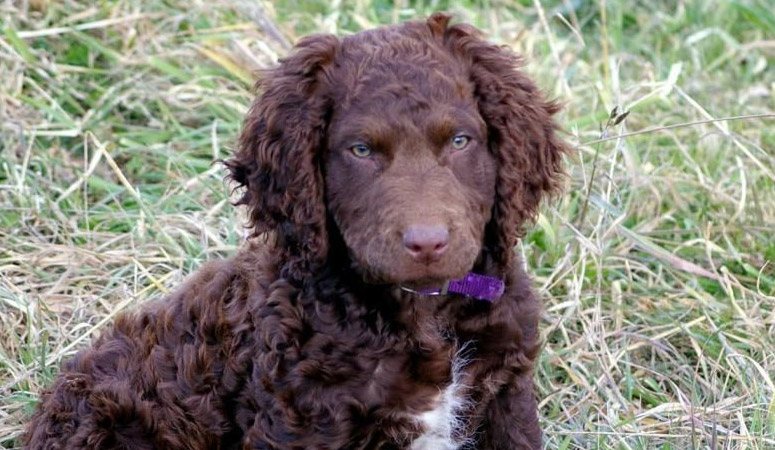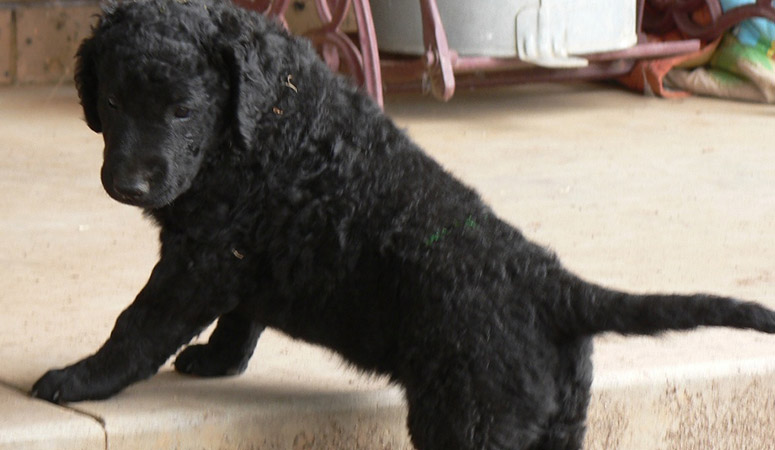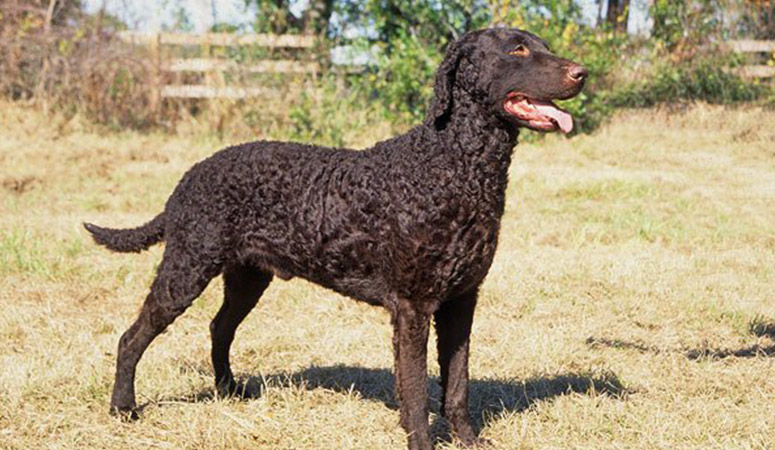Curly-Coated Retriever
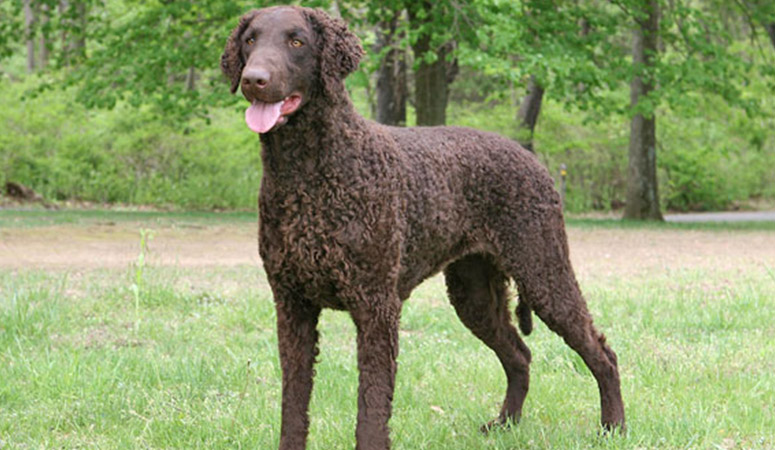
Originated from England, the Curly-Coated Retriever was bred for waterfowl hunting and upland bird. He can be easily distinguished as the tallest one among the retrievers. They can serve as work in thick bramble and icy lakes with tight, crisp curl coat, which makes them peerless swimmers. Although independent and less needy, they are happy to stay with loved ones, but aloof with strangers.
| Other Names | Curly, CCR |
| Color | Black, Liver |
| Height | Male: 25-27 inches, Female: 23-25 inches. |
| Weight | Male: 60-95 pounds, Female: 60-95 pounds. |
| Life Span | 10-12 years |
| Personality | Confident, Proud, Wickedly Smart |
| Exercise | Needs Lots of Activity |
| Origin |
| Popularity | #163 |
| Groom Needs | Occasional Bath/Brush |
| Kids Friendly | Yes |
| Dog Friendly | Yes with supervision |
| Watch Dog | |
| Family Dog | Yes |
| Litter Size | 7-8 puppies |
Curly-Coated Retriever Pictures
Curly-Coated Retriever Video
Introduction
Bred as a versatile dog breed to hunt birds in the uplands and the waters, the Curly-coated Retriever is well-muscled and balanced, with a remarkable level of endurance. They are friendly with their family and occasionally aloof towards strangers. They require enough exercise, and a different style of it to spice things up as they can easily get bored. The thick and tight curls of their coat give the Curly protection from the weather and from work hazards such as chilly ice conditions. Only solid black and solid liver colors are acceptable, although little white markings may be tolerated.
A standard male of this breed stands 25-27 inches from shoulder to paw and weighs around 65-95 pounds. A similar female is likely to tip the scales in the range of 55-85 pounds, standing 23-25 inches at the withers. The Curly is classified as a member of the Sporting Group by the American Kennel Club (AKC). They have an average life expectancy of 9-12 years.
Living with Curly-Coated Retriever
A Curly-Coated Retriever has a relatively easy-care coat and usually sheds only twice a year, although the amount of shedding varies among individual dogs.
Shedding season is also a good time to give him a bath. He shouldn’t need one on a regular basis unless he’s gotten into something stinky. Use a shampoo made for dogs to keep the coat from drying out. Most Curly coats dry quickly, sometimes in as little as ten minutes. Don’t blow dry a Curly unless you want him to look like a chia pet.
Brush or comb your Curly when he’s shedding in the spring and fall, using a wood or plastic wide-toothed comb. Frequent brushing or combing can give his curly coat the frizzies, and swimming or otherwise wetting his coat can help tame the frizzies.
As with all breeds, it’s important to start grooming your Curly-Coated Retriever puppy when he’s young, which will make grooming a positive and soothing experience, and he’ll be easier for you and other people to handle when he’s grown.
Trim his nails as needed so they don’t catch on something and tear. If you can hear them clicking on the floor, they’re too long.
As you groom, take time to check your Curly’s overall condition. Keep an eye out for sores, rashes, or signs of infection such as redness or discharge anywhere on his body.
Check the ears on a weekly basis for signs of infection, irritation, or wax build up. Cleanse regularly with a veterinarian-approved cleanser and cotton ball.
Brush the teeth at least once per week to prevent tartar buildup and fight gum disease.
Curly-Coated Retrievers need a half hour to an hour a day of exercise and stimulation. One of the best ways to keep a Curly active and stimulated is to provide him with a variety of jobs, from walks to swimming to carrying light items for you.
Curlies do need a fair amount of exercise but are also wonderful about settling down and relaxing at home. They are not a breed who is good at being left alone for long periods of time and they’ll be very happy to spend time indoors at home with their people. The breed is very easy to live with as long as they have been shown their “good manners” with basic training.
Puzzle toys such as Buster Cubes will keep Curlies entertained, as will training them for obedience, agility, and other dog activities.
But young Curly puppies should not be given too much exercise because their joints and bones are still growing. They should not be allowed to jump up or off furniture nor should they be allowed to run up and down the stairs, which will increase too much pressure on their joints and result in causing a dog a few problems later on in their lives.
The majority of Curly-Coated Retrievers do well on a diet of good-quality dry dog food. It is best to feed dry food as it will help to eliminate plaque buildup on the teeth which can cause inflamed gums, tooth decay and smelly breath. The Curly should never be fed one large meal. The recommended daily amount is about 3 to 4 cups, divided into two meals.
Not every dog food is appropriate for every dog. Try different foods until you find the one that meets your Curly’s individual dietary needs. You’ll know you’ve found it when he has a super coat and skin.
How much your adult dog eats depends on his size, age, build, metabolism, and activity level. The quality of dog food you buy also makes a difference — the better the dog food, the further it will go toward nourishing your dog and the less of it you’ll need to shake into your dog’s bowl.
Some dogs are prone to getting overweight, so watch your dog’s calorie consumption and weight level. Treats can be an important aid in training, but giving too many can cause obesity, which can shorten a dog’s life by several years, so it’s important to keep an eye on their waistline from the word go.
Clean, fresh water should be available at all times.
Learn about which human foods are safe for dogs, and which are not. Check with your vet if you have any concerns about your dog’s weight or diet.
All dogs have the potential to develop genetic health problems, just as all people have the potential to inherit a particular disease. The Curly’s health concerns may include gastric dilatation and volvulus (bloat), canine follicular dysplasia, entropion, distichiasis, cataracts, epilepsy, generalized progressive retinal atrophy, glycogen storage disease and hip dysplasia.
Not all Curlies will get any or all of these diseases, but it’s important to be aware of them if you’re considering this breed.
As with all breeds, the Curly’s ears should be checked regularly for signs of infection, and the teeth should be brushed often, ideally every day, using a toothpaste formulated for dogs.
There are several health tests considerations specific to the breed, such as ophthalmologist evaluation, cardiac exam and hip evaluation.
Responsible breeders test all breeding stock for conditions that can affect the breed. Regular visits to the vet for checkups and parasite control help to ensure the dog a long, healthy life.
Total Annual Cost: $3239
Cost is estimated for the first year and may vary depending on many factors, such as dog food, health care, leash, collar, licensing, possible fencing, crates, training and obedience classes, dog-walking, grooming, treats, toys, flea, tick, and heart-worm meds, microchips, etc.
The owner of a Curly-Coated Retriever needs to be firm but kind in training of the dog. They are an intelligent breed and smart enough to need an owner who is smarter than they are.
Puppies should be properly socialized to develop the amiable, outgoing personality that is characteristic of the breed. Early training is a must, and it’s a great way to bond with your active pup. Although with a high activity level, but they also need lots of naps to recharge, so the hard exercise you might give an adult isn’t necessary for them.
They will turn tail if the training is too rough, but if too soft or unclear, and they will not pay attention. Two things can help remember regarding training a Curly: First, avoid too much repetition, as the dog may become bored and lose interest. Also, it is important for an owner to try to make the learning situation as much fun as possible. Some Curlies do very well in the obedience ring, but for some the repetition of some of the exercises can cause disinterest.
Training for fieldwork takes a knowledgeable approach and should not be rough. Find a training group in your area with whom you can train, and observe their methods before deciding to join if you are new to the breed and interested in starting field training.
To keep your puppy safe and to help with housetraining, crate training is recommended, which benefits every dog as a kind way to ensure that your Curly doesn’t have accidents in the house or get into things he shouldn’t. Crate training at a young age will help your Curly accept confinement if he ever needs to be boarded or hospitalized. But never stick your Curly in a crate all day long. Curlies are people dogs, and they aren’t meant to spend their lives locked up in a crate or kennel.
They’re successful in performance and companion events such as earthdog, barn hunt, obedience, and agility.
History
The Curly-coated Retriever is believed to be one of the oldest retriever breeds to have existed. Retrievers are probably a more recent class of sporting dogs relative to other such groups as the setters and the spaniels. The Curly-coated Retriever is equally the tallest amongst all retrievers and has the appropriate amount of courage and tenacity to back it up. Although historical evidence and documentation of the early existence of the breed are lacking, there are speculations pointing towards the 1860s as the period when the breed took origin and shape in England. The breeds which were cross-bred to form the Curly-coated Retriever are quite vague, although historians suggest the English Water Spaniel, Irish Water Spaniel, Retriever Setter, Poodle, and the St. John Water Dogs.
However, the Curly-coated Retriever only lasted at the top of the ladder so long for the Labrador Retriever breed to displace it upon creation. The Labrador took over the job of the Curly-coated and, as such, was soon a hands-down favorite. The incidence of the Second World War dragged the towering Curly-coated Retriever to its knees, population-wise. They were reduced to only less than 10 surviving members of the breed.
The breed was first imported into the U.S in 1907 and entered the AKC Studbook in 1924. A breed club, the Curly-Coated Club of America, was founded in 1979. Ever since, dogs of this breed have been bred in different parts of America, although they are yet to regain the initial popularity they had.
Helpful Information
Breed Club: CURLY-COATED RETRIEVER CLUB OF AMERICA
Breed Club Link: http://www.ccrca.org/
Breed Club Rescue:

